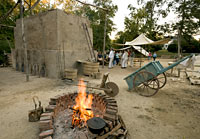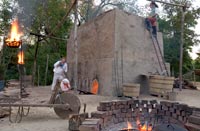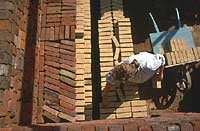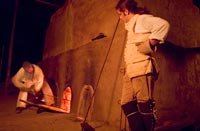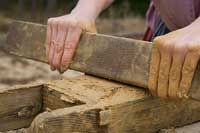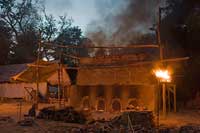Page content
Brickmakers
- Bricks used in new construction and repair throughout Williamsburg
- Unskilled laborers made bricks
- Landowners assigned slaves to brickmaking
- Autumn brickfiring tradition widely anticipated today
Unskilled men, women, and children made bricks
In 18th-century Virginia, slaves, poor unskilled free laborers, and sometimes indentured or convict servants practiced the brickmaking trade. In large yards owned and overseen by a master and in family-owned businesses, men, women, and children participated in the trade.
Wealthy landowners assigned slaves to brickmaking
Wealthy landowners building a plantation home may have assigned a number of their slaves to make bricks for the new structure. Thomas Jefferson's slaves made the bricks for Monticello. His journal noted a crew of three laborers assisting one molder could mold 2,000 bricks in a day. Carter Burwell charged his slaves with making bricks for his mansion house at Carter's Grove, employing brickmaker David Minitree to oversee the work in 1751. The art of firing the kiln was left to Minitree; apparently Burwell was pleased with the outcome as he gave this brickmaker a gift of 25 pounds – a large sum of money at the time!
Brickmaking important in Williamsburg history
In Williamsburg, Samuel Spurr was commissioned to build the wall around the Bruton Parish Church in 1752. Builder Benjamin Powell, working on the Public Hospital, subcontracted the brickwork to Spurr in 1771. Spurr advertised for bricklayers and plasterers in the Virginia Gazette in 1773. By 1779, as the pace of new construction had slowed in Williamsburg, bricklayer and plasterer Humphrey Harwood – noted in the Virginia Gazette as the "chief workman in the city of Williamsburg" – oversaw repair work to many of the public and private structures in town. Harwood burned bricks, turned oyster shells to lime, and made his own mortar. At his death, he had become quite prosperous, owning several slaves, a plantation and a house on the north side of Duke of Gloucester Street.
Colonial Williamsburg Brickyard
Today, Colonial Williamsburg's brickyard is located between the Peyton Randolph House and the Cabinetmaker's shop. Just as Humphrey Harwood and Samuel Spurr expanded their business in colonial times, the brickyard has grown. Visitors to the brickyard can watch bricks being made during the warm months and see the dramatic firing of the brick kiln in the fall. The brickmakers often ask visitors to help with their chores. Children particularly enjoy stomping water into the clay with their bare feet.
Bricks made on site at the brickyard have recently been used in building the Peyton Randolph smokehouse, dairy, and lumberhouse foundations, and the foundation and center chimney of the Randolph kitchen. The brickmakers are currently experimenting with 18th-century lime burning, mortar making, bricklaying, and plastering techniques. With all the foundations, chimneys, and walkways made of brick in The Revolutionary City, the brickmakers should remain busy for years to come!
How bricks are made
Bricks are made from native Virginia clay during the warm months of the year. First, clay is shoveled into a treading pit. Working in the pit, brickmakers use their feet to stomp water into the clay. As soon as it is a smooth consistency, the clay is pulled from the pit and piled upon a molding table.
Before being shaped in a wooden mold, the form and a brick-sized loaf of clay are dusted with sand to keep the clay from sticking, and roots, leaves, sticks, and debris are cleaned from the clay. The molder throws each loaf of clay into the mold. The excess clay is removed by drawing a straight, wooden stick across the top of the form. The filled mold is "off-beared," or carried to raised beds of sand for drying. Once there, the soft bricks are dropped out of the mold and left to dry. After a week or so, the somewhat-dry bricks are placed in a drying shed. Protected from the weather, the bricks are stored and will continue drying for six more weeks.
Stacking and firing the kiln is part of the art of brickmaking. First, bricks are used to set four walls with arched fire tunnels. Approximately 20,000 bricks are stacked in the oven, always a finger's width apart to allow the fire to draft upward. After the structure is sealed with clay, wood is placed in the tunnels, and the fires are lit. The fires burn for about six days and nights, and the brickmakers remain on site during the entire burn period, getting little sleep and keeping the fires burning and the wood stacked and ready to add to the fire. Near the end of the burn, the kiln reaches a temperature of 1,850 degrees Fahrenheit.
The bricks inside the kiln glow yellow, and flames travel from the fire tunnels up and out the top of the oven. Sometimes, the edges of the bricks facing into the fire tunnels receive a glaze. After approximately seven days of burning, the brickmakers let the fires bank, close the fire tunnels and reseal the kiln with clay. The fired bricks must cool for at least a week before the kiln can be unstacked. Each kiln firing yields several qualities of bricks. About half of the kiln contains well-baked bricks. The remaining bricks are either under-fired salmon colored, best saved for interior walls, or over-fired, purple and blue "clinkers."

